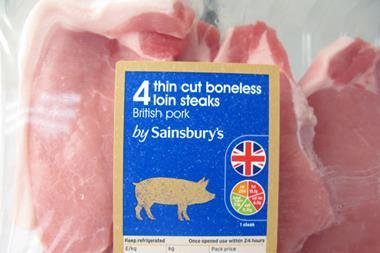
There’s no sugar-coating this: the profitability of the meat industry, as revealed by The Grocer/OC&C Food & Drink 150, is alarming. Of the 22 meat and poultry businesses, less than half are achieving margins over 2%, and in the case of red meat producers, it’s just a third (see right).
To put this in context, the average margin across the fmcg sector in 2012 was 5.2%.
Thin margins in meat - and especially in poultry - are nothing new, but in the wake of the horsemeat scandal, the sector’s underperformance against other parts of grocery will be noted with particular concern. Indeed, consultants OC&C - who compile the data for the Food & Drink 150 - found a “long tail of underperforming meat companies” contributing to “recent ruptures” in the meat sector, such as Vion’s exit from the UK. But the biggest rupture of all, of course, was Horsegate.
So why are margins such a struggle and what can be done to improve profitability?
Red meat company revenues and operating margins
- Hilton 1,034
- Vion Food UK (red meat) 800
- Woodhead Bros* 569
- Fletcher Bay* 497
- Dawn Meats 299
- Linden Foods 283
- Dovecote Park 156
- Randall Parke r119
- NZ Farmers 100
Operating margins:
■ >3% ■ 2-3% ■ <2%
Notes: * includes pork or poultry sales
Source: annual reports, OC&C analysis
The causes are not difficult to see. Meat remains, in essence, a commodity, with very little branding or segmentation farmgate prices for livestock are high retailers are demanding low prices plus, there is overcapacity in UK processing.
“That’s not a very comfortable place to be for meat processors,” says Stephen Rossides, director of the British Meat Processors Association, especially since meat processors are also facing high regulatory costs. “Clearly, the best are making money, by investing in modern processes, maximising the value of the carcase and finding lucrative export markets. but there are many others that are being left behind and are struggling.”
This is obvious from OC&C’s data, which shows margins from 13.9% to -3.2% for the meat companies in the 150.
Tough margins don’t necessarily mean people will be cutting corners, but where profitability is consistently under pressure, questions need to be asked. “When you take a supply base where lots of people don’t have long-term sustainable businesses and combine that with a fiercely competitive market and complex supply chains, you are looking at conditions where corner cutting might be more likely,” says OC&C partner Will Hayllar.
And the meat industry doesn’t just have to worry about possible fraud. “When you are looking at margins below 2%, companies might not have the returns to reinvest in capital equipment or to be innovative,” says Hayllar. Long-term, that means the UK meat industry’s ability to compete decreases.
The way out? As well as greater efficiency and added value, greater integration between retailers and meat suppliers is already evident in the UK. Morrisons has operated integrated supply chains for some time, but in April 2012 bought out Cranswick’s stake in a JV facility Asda has been strengthening its links with Forza and Kober and Waitrose extended its 10-year link with Dovecote Park into frozen beef. Experts predict more of the same. “Crucially, if you have that longer-term relationship, the fact your margins might not be that high on an absolute basis matters less because suppliers have greater certainty and therefore more confidence to invest,” says Hayllar.
“With long-term relationships, absolute margins matter less “
Will Hayllar, OC&C
Duncan Rawson, a partner at EFFP, agrees. “Volatility is often a bigger problem than precisely what margin you make.”
The breakup of Vion earlier this year and the acquisition of its poultry and red meat businesses by 2 Sisters Food Group. “will also help to drive consolidation of an overcapacity market,” predicts OC&C, “further strengthening the position of scale players.”
With Horsegate providing the perfect incentive for all parts of the meat supply chain to reassess business practices and priorities, suppliers will be hoping retailers will give them more of that much-needed certainty - and allow their margins to catch up with the rest of the grocery sector soon.



















No comments yet